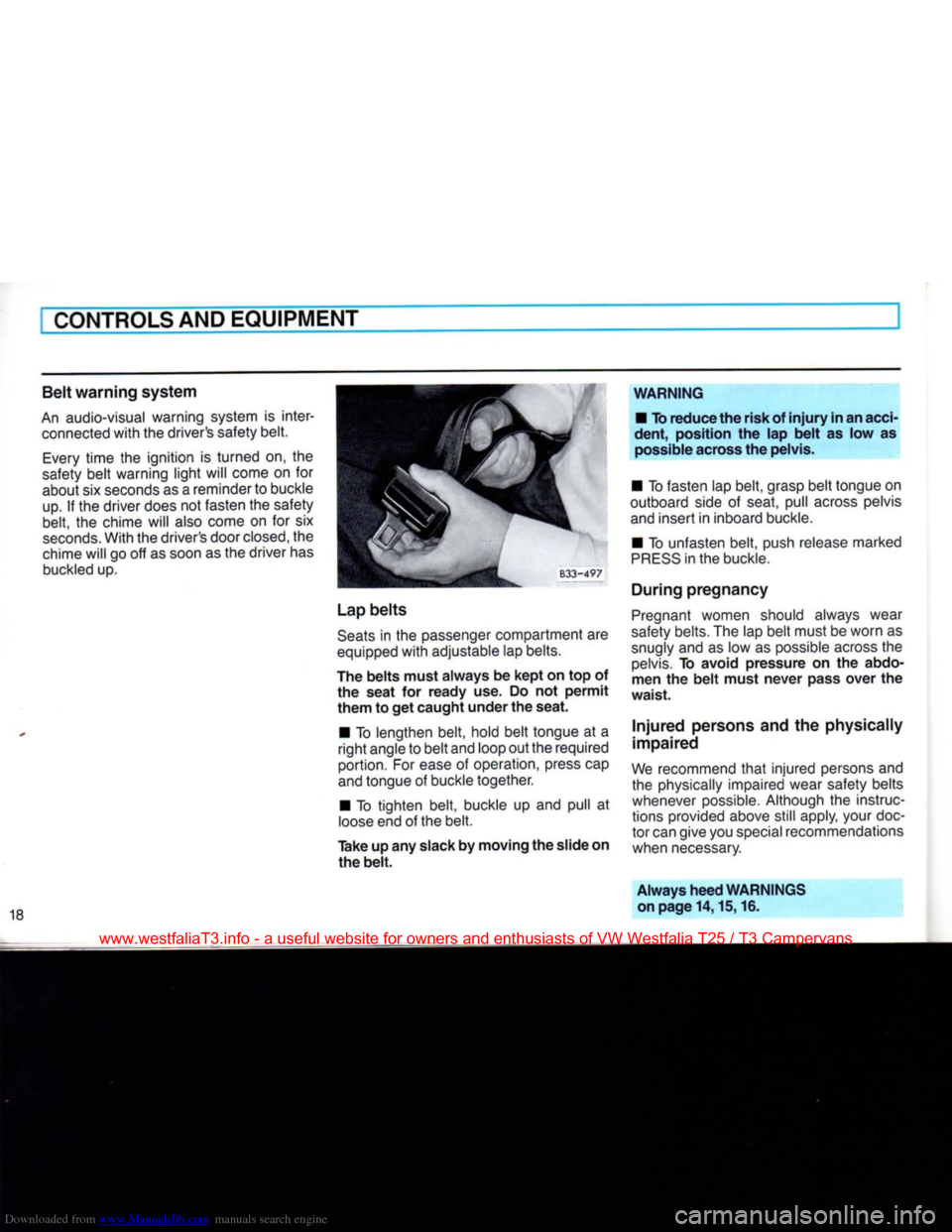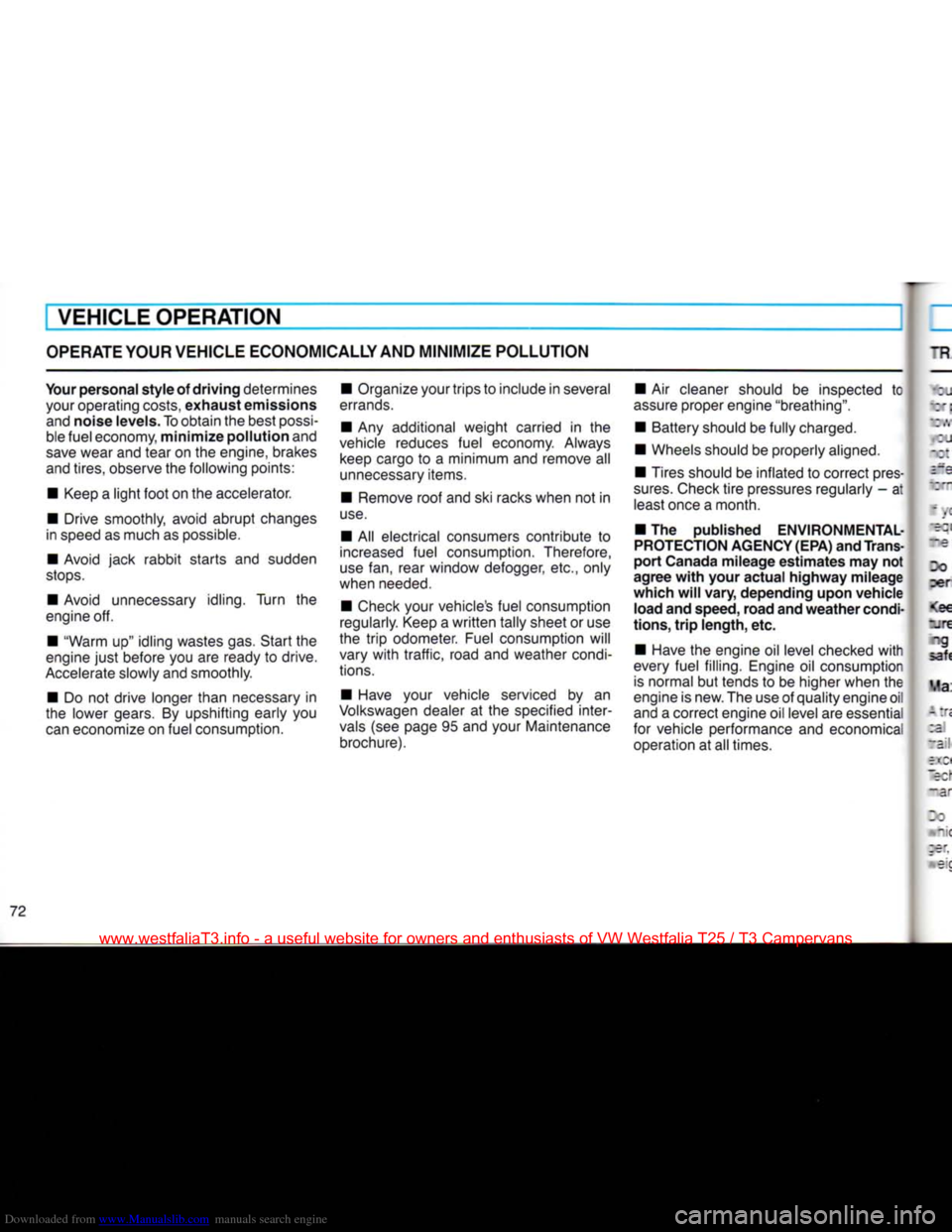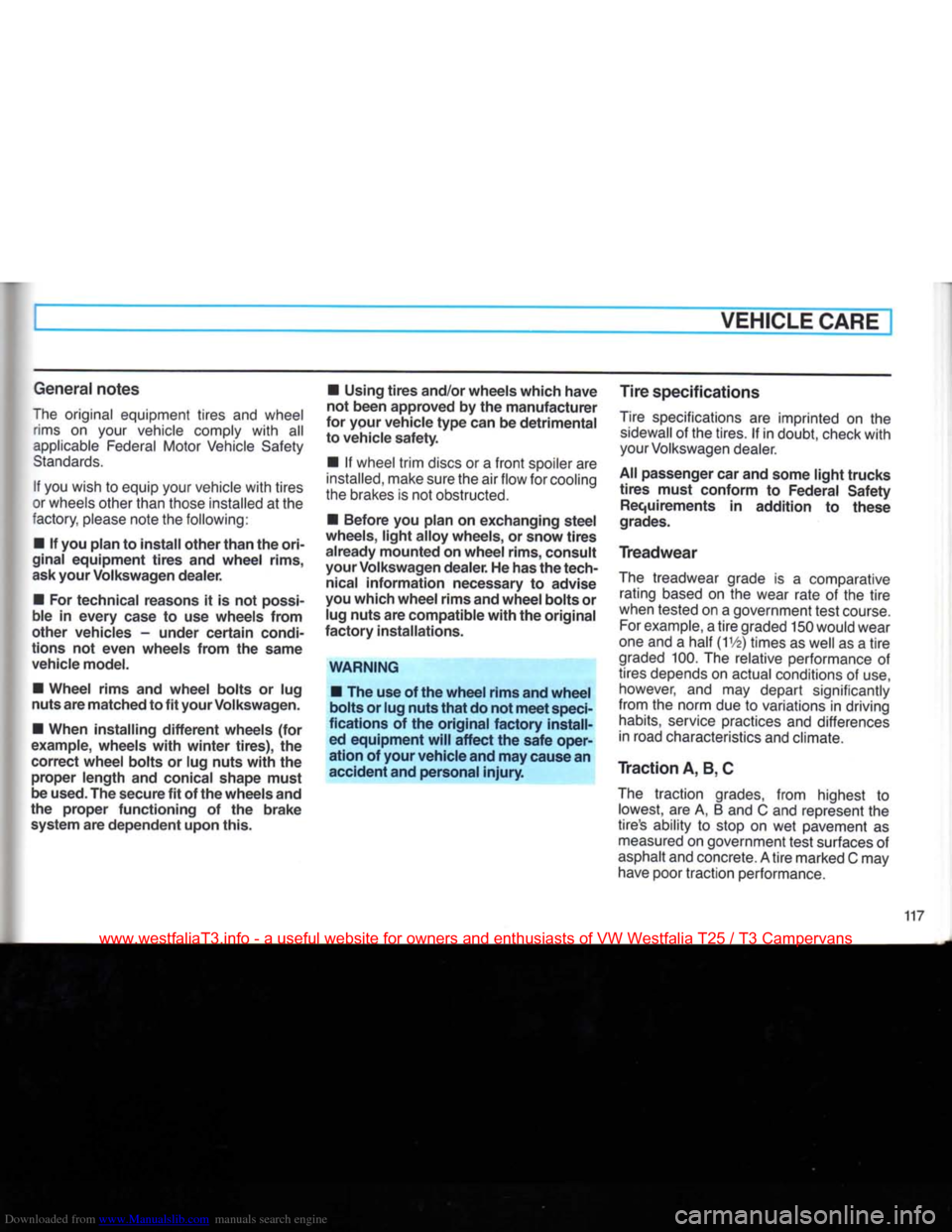1990 VOLKSWAGEN TRANSPORTER length
[x] Cancel search: lengthPage 19 of 165

Downloaded from www.Manualslib.com manuals search engine
CONTROLS AND EQUIPMENT
Belt
warning
system
An
audio-visual warning system is inter
connected
with
the driver's safety belt.
Every
time the ignition is turned on, the
safety belt warning light will come on for about six seconds as a reminder to buckle
up.
If the driver does not fasten the safety
belt, the chime will also come on for six
seconds.
With the driver's door
closed,
the
chime will go off as soon as the driver has
buckled
up.
Lap
belts
Seats
in the passenger compartment are
equipped
with
adjustable lap belts.
The
belts
must
always
be
kept
on top of the
seat
for
ready
use. Do not
permit
them
to get
caught
under
the
seat.
• To lengthen belt, hold belt tongue at a
right
angle to belt and loop out the required
portion. For
ease
of operation, press cap
and
tongue of buckle together.
• To tighten belt, buckle up and pull at
loose
end of the belt.
Take
up any slack by
moving
the slide on the
belt.
WARNING
• To
reduce
the
risk
of
injury
in an acci
dent,
position the lap
belt
as low as
possible across the pelvis.
• To fasten lap belt, grasp belt tongue on
outboard side of seat, pull across pelvis
and
insert in inboard buckle.
• To unfasten belt, push release marked
PRESS
in the buckle.
During
pregnancy
Pregnant
women should always wear
safety belts. The lap belt must be worn as
snugly and as low as possible across the
pelvis.
To avoid pressure on the abdo
men the
belt
must
never
pass
over
the
waist.
Injured
persons and the physically
impaired
We
recommend
that
injured persons and the physically impaired wear safety belts
whenever possible. Although the instruc
tions provided above still apply, your doc
tor can give you special recommendations
when necessary.
Always
heed
WARNINGS
on
page
14,15,16.
www.westfaliaT3.info - a useful website for owners and enthusiasts of VW Westfalia T25 / T3 Campervans
Page 73 of 165

Downloaded from www.Manualslib.com manuals search engine
VEHICLE OPERATION
OPERATE
YOUR VEHICLE ECONOMICALLY AND
MINIMIZE
POLLUTION
Your
personal
style
of
driving
determines your operating costs,
exhaust
emissions and noise levels. To obtain the best
possi
ble fuel economy,
minimize
pollution
and
save
wear and tear on the engine, brakes
and tires, observe the following points:
• Keep a
light
foot
on the accelerator.
• Drive smoothly, avoid abrupt changes
in speed as much as possible.
• Avoid jack rabbit starts and sudden
stops.
• Avoid unnecessary idling. Turn the
engine off.
• "Warm up" idling wastes gas. Start the
engine
just
before you are ready to drive.
Accelerate
slowly and smoothly.
• Do not drive longer than necessary in
the lower gears. By upshifting early you
can
economize on fuel consumption. • Organize your trips to include in several
errands.
• Any additional weight carried in the
vehicle reduces fuel economy. Always keep cargo to a minimum and remove all
unnecessary
items.
• Remove roof and ski racks when not in
use.
• All electrical consumers contribute to
increased
fuel consumption. Therefore,
use
fan, rear window defogger, etc., only
when needed.
• Check your vehicle's fuel consumption
regularly. Keep a
written
tally sheet or use
the
trip
odometer. Fuel consumption will
vary
with
traffic, road and weather condi
tions.
• Have your vehicle serviced by an
Volkswagen
dealer at the specified inter
vals
(see page 95 and your Maintenance brochure). • Air cleaner should be inspected to
assure
proper engine "breathing".
• Battery should be fully charged.
• Wheels should be properly aligned.
• Tires should be inflated to correct pres
sures.
Check
tire
pressures regularly - at least once a month.
• The published ENVIRONMENTAL-
PROTECTION AGENCY (EPA) and Trans
port
Canada
mileage
estimates
may not
agree
with
your
actual
highway
mileage
which
will
vary,
depending
upon
vehicle
load
and speed,
road
and
weather
condi
tions,
trip
length,
etc.
• Have the engine oil level checked
with
every fuel filling. Engine oil consumption
is
normal but tends to be higher when the
engine is new. The use of quality engine oil
and a correct engine oil level are essential
for vehicle performance and economical operation at all times.
72
www.westfaliaT3.info - a useful website for owners and enthusiasts of VW Westfalia T25 / T3 Campervans
Page 122 of 165

Downloaded from www.Manualslib.com manuals search engine
VEHICLE
CARE
General notes
The original equipment tires
and
wheel
rims
on
your
vehicle comply with
all
applicable
Federal Motor Vehicle Safety
Standards.
If you
wish
to
equip
your
vehicle with tires
or wheels other than those installed
at the
factory, please note
the
following:
•
If
you plan
to
install other than the
ori
ginal
equipment tires
and
wheel rims,
ask
your
Volkswagen dealer.
•
For
technical reasons
it is not
possi
ble
in
every
case
to use
wheels from
other vehicles
-
under certain condi
tions
not
even wheels from
the
same
vehicle
model.
•
Wheel rims
and
wheel bolts
or lug
nuts are matched to fit
your
Volkswagen.
•
When installing different wheels
(for
example,
wheels with winter tires),
the
correct wheel bolts
or
lug nuts with
the
proper length
and
conical shape must
be used. The secure fit of the wheels and
the proper functioning
of the
brake system are dependent upon this.
•
Using tires and/or wheels which have
not been approved
by
the manufacturer
for
your
vehicle
type
can be detrimental
to vehicle safety.
•
If
wheel trim discs
or a
front
spoiler
are
installed,
make
sure the airflow for cooling
the brakes
is not
obstructed.
•
Before
you
plan
on
exchanging steel
wheels, light alloy wheels,
or
snow tires
already mounted on wheel rims, consult
your
Volkswagen dealer. He has the tech
nical
information necessary
to
advise
you which wheel rims and wheel bolts
or
lug
nuts are compatible with the original
factory installations.
WARNING
•
The
use of the wheel rims and wheel
bolts
or
lug nuts that do not meet
speci
fications
of the
original factory
install
ed equipment will affect the safe oper
ation
of
your
vehicle and may cause an
accident and personal
injury.
Tire specifications
Tire
specifications
are
imprinted
on the
sidewall
of
the tires.
If in
doubt, check with
your
Volkswagen dealer.
All
passenger car and some light trucks tires must conform
to
Federal Safety
Requirements
in
addition
to
these
grades.
Treadwear
The treadwear grade
is a
comparative
rating
based
on the
wear rate
of the
tire
when tested
on a
government test course. For example,
a
tire graded
150
would wear
one
and a
half
(IV2)
times
as
well
as a
tire
graded 100.
The
relative performance
of
tires depends
on
actual conditions
of use,
however,
and may
depart significantly
from
the
norm
due to
variations
in
driving
habits,
service practices
and
differences
in road characteristics and
climate.
Traction A, B, C
The traction grades, from highest
to
lowest,
are A, B and C and
represent
the
tire's ability
to
stop
on wet
pavement
as
measured
on
government test surfaces
of
asphalt
and concrete. Atire marked
C
may
have poor traction performance.
www.westfaliaT3.info - a useful website for owners and enthusiasts of VW Westfalia T25 / T3 Campervans
Page 153 of 165

Downloaded from www.Manualslib.com manuals search engine
I TECHNICAL DATA
DIMENSIONS
Station
Kombi
Camp-
Pick-up
Wagon
mobile
in mm in mm in mm in mm
Length 179.9 4570
179.9 4570 179.9
4570 179.9
4570
Width 72.6 1845
72.6 1845 72.6
1845 72.6 1845
Height (unladen) .... 77.2
1960 77.2
1960 81.6 2075 75.9 1930
Angle
of approach .... 21° 21° 21° 21°
Angle
of depature .... 19° 19° 19° 19°
Wheelbase
96.9 2460 96.9 2460 96.9 2460 96.9 2460
Front track 62.4
1585 62.4
1585 62.4 1585 62.4 1585
Rear
track 61.8 1570
61.8 1570
61.8 1570 61.8 1570
Ground
clearance
with
gross
vehicle weight
front
7.5
190 7.5 190
7.5 190 7.5 190
rear 8.0
204 8.0 204 8.0 204 8.0 204
Turning circle diameter . approximately 35
ft/10.7
(wall
to wall)
Ramp
angle 22° 22° 22° 22°
Ground
clearance is reduced by approximately 1.2 in (30 mm)
on vehicles having a lowered
chassis.
When driving up steep ramps, on rough roads, over curbs, etc. it is
important
to remember
that
some parts of your car are close
to the ground, such as spoilers or exhaust system components.
Be
sure to avoid damage.
148
www.westfaliaT3.info - a useful website for owners and enthusiasts of VW Westfalia T25 / T3 Campervans
Page 154 of 165

Downloaded from www.Manualslib.com manuals search engine
TECHNICAL DATA
Syncro Station
Kombi Camp-
Pick-up
Syncro Wagon
mobile
in mm in mm in
mm in mm
Length 179.9 4570 179.9 4570 179.9
4570 179.9 4570
Width 72.6 1845
72.6 1845 72.6
1845 73.6 1870
Height (unladen) .... 78.3
1990 78.3 1990 82.8
1990 77.2
1960
Angle of approach .... 22°
22° 22°
22°
Angle of depature .... 19°
19° 19°
19°
Wheelbase 96.6
2455 96.6 2455 96.6
2455 96.6
2455
Front track 61.7
1568 61.7 1568 61.7
1568 61.4
1560
Rear track 61.4 1560 61.4
1560 61.4
1560 61.4
1560
Ground clearance with
gross vehicle weight front 8.5
215 8.5 215
8.5 215 8.5
215
rear 7.6 193
7.6 193
7.6 193
7.6 139
Turning circle diameter . approximately 36 ft/10.9 (wall to wall)
Wading depth 11.3 290 11.3 290
11.3 290 11.3
290
Ramp angle 24°
24° 24°
24°
When driving up steep ramps, on rough roads, over curbs, etc. it is important to remember that some parts of your car are close
to the ground, such as spoilers or exhaust system components. Be sure to avoid damage.
149
www.westfaliaT3.info - a useful website for owners and enthusiasts of VW Westfalia T25 / T3 Campervans